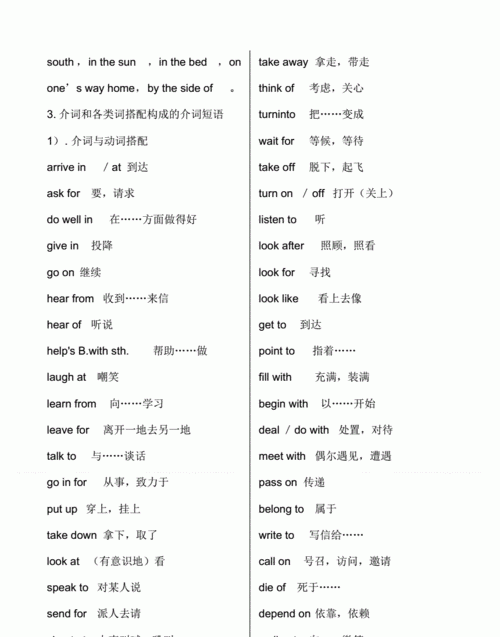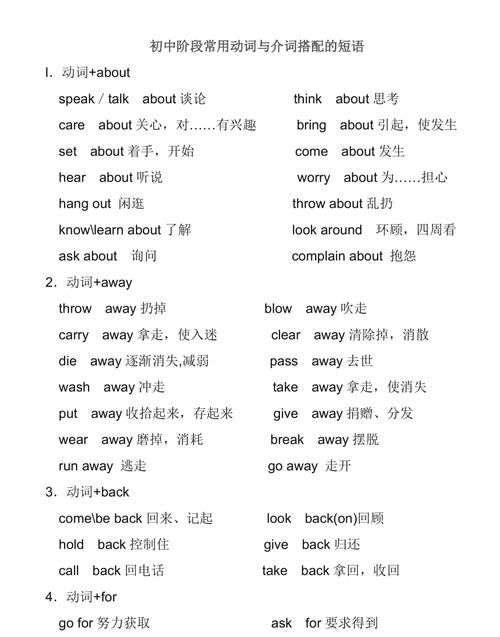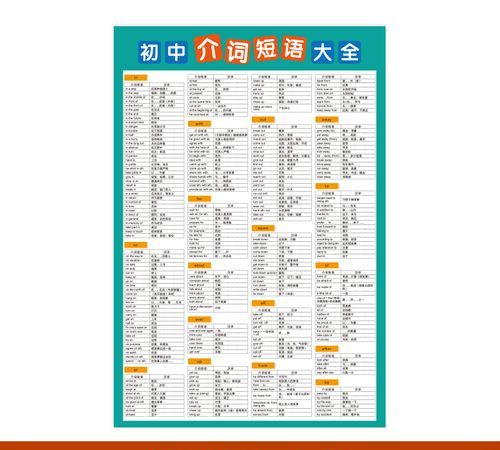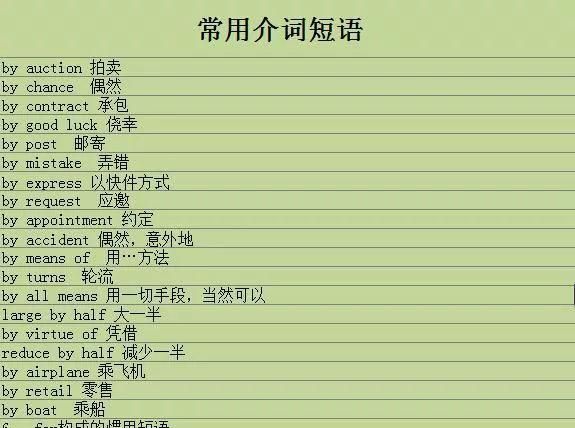本文目录
初中英语常用介词50个
1)简单介词:about, across, after, against, among, around, at, before, behind, below, beside, but, by, down, during, for, from, in, of, on, over, near, round, since, to, under, up, with等等。
2)合成介词:inside, into, outside, throughout, upon, without, within
3)短语介词:according to, along with, apart from, because of, in front of, in spite of, instead of, owing to, up to, with reguard to
4)分词介词:considering, reguarding, including, concerning
2.从意思上考虑,介词可分为下面三类:
1)引导时间短语的介词:
at, on, in, during, before, after, over, from, following, by, till, until, towards, for, throughout, upon, since, pending, all through, prior to
2) 引导地点状语的介词:
in, at, across, to, down, under, near, between, over, from, into, through, onto, off, outside, out of, inside, within, beside, behind, below, among, beyond, against, around, before, up, ahead of, via, in front of, under, along, past, opposite, above, next to
3) 引导其他短语的介词:
by, with, about, except, like, of, according to, instead of, without, in, due to, because of, along with, as for, in spite of, on account of owing to, on behalf of, against, apart from, for, failing, plus, including, in regard to, with regard to
偶尔有一些不常用。。。

初中英语介词知识点总结
在英语中,介词虽然是一种小词,但在作用和运用上的复杂性却不可小看。首先,可以毫不夸张地说,离开了介词的中介或连接作用,就无法表达某些最基本的思想或概念。下面是我为您收集整理的初中英语介词知识点:常用介词要点,供大家参考!
初中英语介词知识点:常用介词要点
1、this / that / these / those / last / next / a / every / each等词构成的时间短语,前面不用任何介词。如:Every year travellers from abroad come to visit Pingyao.(每年都有国外的游客来游览平窑镇)/ He had a bad cold that week.(那个星期他患重感冒)
2、for有时用来引出动词不定式的逻辑主语,常翻译成“对于…而言”。如:It's too hard for me to finish the work in only one hour.(让我在区区一个小时内完成这项工作太难了)/ The house is big enough for 10 men to live in.(房子够大的可以容10个人住)
3、of有时用来表示后面的人物正好是前面的表语的逻辑主语。如:It's very nice/kind of you to do so.(你这么做真是太好了)
4、介词有时会与它的宾语分离,而且宾语前置。
①当宾语是疑问词时。Who are you talking about?(你们在谈论谁?)
②宾语在从句中当连接词时。He has a younger brother who he must take good care of.(他有 一个需要他照顾的小弟。) / Do you know who our teacher is talking with over there?(你知道我们的老师在那边和什么人谈话吗?)
动词不定式作定语且该动词为不及物动词,后面有介词。I finally found a chair to sit on.(我 最终找到了一张椅子坐。)
5、记住一些固定词组:arrive at/in(到达…),on foot(步行),not…at all(根本不),to the north of(在…以北),in the east of(在…的东部),in the night(在夜间),at night(在晚上),be afraid of(害怕…),be full of(充满/ 装满…),be filled with(充满/ 装满…),be good/bad for(对…有益/有害),be made of(由…做成),be made from(由…制造),play with(玩耍……),look out of(朝…外面看),at the end of(在…末梢/结束时),by the end of(不迟于…/到…末为止),with the help of或with one's help(在…的帮助下),look after(照料…),look for(寻找…),on a bike(=by bike)骑车, help sb. with(帮某人做…),get on (well) with(与某人相处[融洽]),等等。
初中英语介词知识点:介词用法辨析
1、时间或地点介词in、on、at的用法区别:表示时间时,in表示在一段时间里(在将来时句子中则表示在一段时间之后),on表示在具体的某一天或者某天的上下午等, at表示在某个时刻或者瞬间;表示地点时,in表示在某个范围之内,on表示在某个平面上或与一个面相接触,at则表示在某个具体的场所或地点。如:He was born on the morning of May 10th.(他出生于五月十日的早晨)/ I usually get up at 7:00 in the morning.(我通常在早上的七点钟起床) / His glasses are right on his nose.(他的眼镜就架在他的鼻子上)/ He is at the cinema at the moment.(此刻他正在电影院)
2、after与in表示时间的用法区别:“after+(具体时刻/从句)”表示“在…时刻之后”常用于一般时态;“in+(一段时间)”表示“在(多久)之后”,常用于将来时态。如:He said that he would be here after 6:00.(他说他六点钟之后会来这儿)/ My father is coming back from England in about a month.(我父亲大约一个月以后从英国回来)
3、since与for表示时间的用法区别:“since+(具体时刻/that-从句)”表示“自从…起一直到现在”,“for +(一段斶间)”表示“总共有…之久”,都常用于完成时态;如:Uncle Li has worked in this factory since 1970.(李叔叔自从1970年起就在这家工厂工作了)/ Uncle Li has worked in this factory for over 30 years. (李叔叔在这家工厂已经工作了30多年)
4、by、in与with表示方式的用法区别:都可以表示“工具、手段”,但是by主要表示“乘坐”某个交通工具或“以……方式”,在被动句中可以表示动作的执行者;in表示“使用”某种语言/文字,with表示“使用”某个具体的工具、手段。如:We see with our eyes and walk with our feet.(我们用眼睛看东西,用双脚走路)/ Please write that article(文章) in English.(请你用英语写那篇文章)/ Let's go to the zoo by taxi.(我们打的去动物园吧。)/ It was written by Lao She.(那是老舍写的)
5、about与on的用法区别:都可以表示“有关…”,但是about的意义比较广,而on主要表示“有关…(专题/课程)”。如:Tom is going to give a talk on the history of America.(汤姆要作一个美国历史的报告)/ They are very excited talking about the coming field trip.(他们兴致勃勃地谈论着即将来到的野外旅游)

初中的英语中常用的介词有哪些?
英语中最常用的介词,按照不同的分类标准可分为以下几类:
(1). 简单介词、复合介词和短语介词
①.简单介词是指单一介词。如:
at , in ,of ,by , about , for, from , except , since, near, with 等。
②. 复合介词是指由两个简单介词组成的介词。如:
Inside, outside , onto, into , throughout, without , as to as for , unpon, except for 等。
③. 短语介词是指由短语构成的介词。如:
In front of , by means o f, on behalf of, in spite of , by way of , in favor of , in regard to 等。
(2). 按词义分类
{1} 表地点(包括动向)的介词。如:
About ,above, across, after, along , among, around , at, before, behind, below, beneath, beside, between , beyond ,by, down, from, in, into , near, off, on, over, through, throught, to, towards,, under, up, unpon, with, within , without 等。
{2} 表时间的介词。如:
About, after, around , as , at, before , behind , between , by, during, for, from, in, into, of, on, over, past, since, through, throughout, till(until) , to, towards , within 等。
{3} 表除去的介词。如:
beside , but, except等。
{4} 表比较的介词。如:
As, like, above, over等。
{5} 表反对的介词。如:
againt ,with 等。
{6} 表原因、目的的介词。如:
for, with, from 等。
{7} 表结果的介词。如:
to, with , without 等。
{8} 表手段、方式的介词。如:
by, in ,with 等。
{9} 表所属的介词。如:
of , with 等。
{10} 表条件的介词。如:
on, without , considering 等。
{11} 表让步的介词。如:
despite, in spite notwithstanding等。
{12} 表关于的介词。如:
About, concerning, regarding ,with regard to, as for , as to
{13} 表对于的介词。如:
to, for over , at , with 等。
{14} 表根据的介词。如:
on, according to 等。
{15} 表其他的介词。如:
for(赞成),without(没有)等。

初中英语介词知识点总结
1)简单介词(simple preposition),即单一介词,如at,in,of,since等。
2)复合介词(compound preposition),由两个介词组成,如as for,as to,into,out of等。
3)二重介词(double preposition),由两个介词搭配而成,但没有复合介词那样固定,如from under,from behind,until afterexpect in等。
4)短语介词(phrasal preposition),由短语构成,如according to,because of,in spite of,on behalf of,with reference to等。
5)分词介词(participle preposition),由现在分词如regarding,concerning,including等。
介词还可按其词义分为下列常见的几种:
1)表地点(包括动向),如about,above,after,along,amongat, before,below,beneath,beside,between,beyond,by,down,from,in,,off,on,over,through,throughout,to,under,up,upon,with,within,without等。
[注]
有不少表地点的介词表动向,除很明显的across,around,near,外,
还有
among
,
behind
,
beneath
,
between
,
on
,
to
,
under
等。
2
)表时间,如
about
,
after
,
around
,
as
,
at
,
before
,
behind
,
between
,
by
,
du
ring
,
for
,
from
,
in
,
into
,
of
,
on
,
over
,
past
,
since
,
through
,
throughout
,
til
l(until)
,
to
,
towards
,
within
等。
3
)表除去,如
besides
,
but
,
except
等。
4
)表比较,如
as
,
like
,
above
,
over
等。
5
)表反对,如
against
,
with
等。
6
)表原因、目的,如
for
,
with
,
from
等。
7
)表结果,如
to
,
with
,
without
等。
8
)表手段、方式,如
by
,
in
,
with
等。
9
)表所属,如
of
,
with
等。

以上就是关于初中英语介词大全汇总 ,初中英语常用介词50个的全部内容,以及初中英语介词大全汇总 的相关内容,希望能够帮到您。

